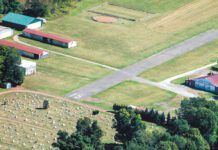The much-heralded promise of GPS/WAAS is ILS-like guidance at nearly every airport without the need for a million dollars worth of ILS equipment. The hero of this effort is the LPV approach—that’s localizer performance with vertical guidance for those of you just coming up to speed.
If you’ve flown these LPV approaches, then you’ll know that even the best of them tend to come up short; about 50 feet short. That is, they have DAs that are 250 feet above touchdown as opposed to the Cat-I ILS standard of 200 feet.
The LPV-200 initiative may give you that extra 50 as new approaches come online and older ones are recharted—so long as they meet the requirements.
What it Takes to Go All The Way
Creating any approach with vertical guidance requires a fair amount of work, including investment for obstruction surveys, approach design, charting the procedure, and publishing the procedure. Terrain and obstructions may prevent any LPV minimums. Even where an LPV approach is feasible, some non-trivial airport requirements must still be met to get ILS-like numbers.
The runway served by an LPV-200 approach should be paved and at least 4200 feet long, though shorter runways may be allowed in some circumstances. The runway must have precision runway markings—the fancy paint you’re used to seeing on ILS runways—holding position signs and markings, runway edge lighting, approach lighting, and a parallel taxiway. The runway must also have a Precision Obstacle Free Zone at the threshold to get the 200-foot DA. Without these elements, the DA goes up.
The point here is that you shouldn’t expect minimums of 200 feet and a half mile at every airport that has an LPV approach.
Approach lights aren’t cheap, but at least RNAV approaches don’t require the expensive ground transmitters, which eases the cost burden and gets more approaches into the world faster. RNAV approaches also aren’t affected by floods, snowstorms, earthquakes or ground accidents, and approaches with LPV minimums don’t require a critical area as you see with many ILSs.
The Satellite Side of Things
Once an RNAV approach has been created, the remaining factor that determines whether or not your GPS receiver will provide LNAV, LNAV/VNAV or LPV minimums depends on the WAAS signal integrity. While you’re busy flying the plane, your WAAS GPS receiver is calculating a Horizontal Protection Level (HPL) and a Vertical Protection Level (VPL) once every second. Think of this as a measure of the maximum error your GPS could have, given the signal quality and satellite positions.
WAAS service volume can shrink or expand from hour to hour, based on a variety of factors including WAAS ground-equipment outages, satellite outages and solar activity. Solar activity can play havoc with GPS signals transmitted from satellites by increasing ionospheric delay, which degrades your GPS receiver’s ability to determine your location.
One way to support a larger WAAS service volume is to increase the number of WAAS ground-based reference stations and this is just what the FAA has done. Several new WAAS reference stations have been commissioned in Alaska, Canada and Mexico. This has significantly expanded the WAAS service volume and made it possible to provide the VPL necessary for LPV-200 approaches throughout the continental U.S., Alaska, Canada, and Mexico.
Another way to increase WAAS signal integrity and support a larger service volume is to increase the number of GPS satellites. Depending on who you talk to, GPS is either an aging system in need of a serious refresh or it is robust and continues to be expanded and enhanced. The truth probably lies somewhere in-between. The Air Force is responsible for getting new GPS satellites into service as the older satellites reach the end of their useful lives. In the past few years, the Air Force has fallen behind schedule in launching replacement satellites.
A recent GAO report expressed concern that because of these delays in launching new satellites, between the years 2015 and 2020 there is around an 80-percent chance we’ll have fewer than the 24 satellites deemed necessary for optimal GPS performance. If these predictions hold true, it could mean erosion of the WAAS service we’re depending on more and more. You might not always have the signal integrity needed for an LPV approach. An added twist may be the increase in solar activity that’s forecast to peak between 2010 and 2011.
There is a plan to increase signal integrity by having new GPS satellites broadcast the current L1 signal (1575.42 MHz) along with a new, civilian, L5 signal (1176.45 MHz). The idea behind L5 is that a dual-frequency GPS receiver could use the currently available WAAS corrections or generate its own ionospheric delay corrections by comparing the L1 and L5 signals. Space Vehicle Number 49 (SVN49) was launched on March 24, 2009 with an L5 demonstration payload. The L5 frequency has been in use by two geostationary WAAS satellites for transmitting WAAS correction messages, but SVN49 became the first satellite to broadcast a GPS L5 signal from a medium-earth orbit.
While dual-frequency GPS receivers promise to provide greater accuracy and a larger GPS service volume, a usable constellation of L5 satellites is not expected until 2018 and there are no dual-frequency general aviation receivers currently available.
Still Room For the ILS
WAAS was developed to provide the accuracy required for RNAV approaches with vertical guidance, and so far it is doing a pretty darn good job. The FAA has done their part by keeping on track with the development of new RNAV approaches and the expansion of the WAAS service volume.
Keeping a minimum number of healthy GPS satellites in orbit may cause a few bumps in the road, but hasn’t yet become an issue for LPV approaches. So we’ll keep looking for more RNAV approaches with LPV minimums that are every bit as low as a Cat-I ILS. But we won’t throw out our trusty localizer receiver—at least for now.
John Ewing is a California CFI who enjoys an LPV to minimums. He blogs at aviationmentor.blogspot.com.




